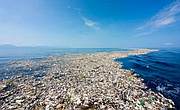Problematic pollution in the Pacific
DEVIN WEEKS | Hagadone News Network | UPDATED 3 years, 10 months AGO
Devin Weeks is a third-generation North Idaho resident. She holds an associate degree in journalism from North Idaho College and a bachelor's in communication arts from Lewis-Clark State College Coeur d'Alene. Devin embarked on her journalism career at the Coeur d'Alene Press in 2013. She worked weekends for several years, covering a wide variety of events and issues throughout Kootenai County. Devin now mainly covers K-12 education and the city of Post Falls. She enjoys delivering daily chuckles through the Ghastly Groaner and loves highlighting local people in the Fast Five segment that runs in CoeurVoice. Devin lives in Post Falls with her husband and their three eccentric and very needy cats. | January 23, 2022 1:08 AM
A massive cluster of trash swirls in the north Pacific Ocean.
It’s known as the Great Garbage Patch, a vortex of marine debris composed of cheap fishing nets and mostly plastic pollution that degrades into smaller and smaller pieces.
The Great Pacific Garbage Patch is bounded by the North Pacific Subtropical Gyre. A gyre is a large system of swirling ocean currents, as defined by the National Oceanic and Atmospheric Administration.
This gigantic collection of garbage is so huge scientists can’t trawl it and it’s nearly impossible to measure. It’s estimated to be 617,000 square miles, according to PBS, and weighs more than 43,000 cars. It contains bottles, toothbrushes, styrofoam cups, shoes and deadly plastic bags that turtles often confuse for jellyfish, one of their favorite foods.
Reid Harlocker is about to go see the Great Garbage Patch in person.
“I started reading about how this plastic gets to where it is,” said Harlocker, of Hayden. “Everything we have in plastic is derived from these small plastic beads. Across the world, we don’t recycle plastics very well. We think we do, but we don’t. Plastics are being flushed down rivers, shoved into the oceans.”
The Pacific plastic pollution problem hits home for Harlocker, a semi-retired communications engineer who is originally from Hawaii. In February and March, he’ll team up with the conservation education group Pangea Exploration. They’ll board the 72-foot Sea Dragon expedition yacht and travel to remote islands and atolls to examine how plastic pollution is damaging coral reefs, wildlife and overall ocean health.
“We’re going to Fanning Island and one other, making stops, diving on the reef and on the beaches, sifting, looking to see what plastic components are in the environment,” Harlocker said.
“While I have quite a bit of experience operating small and mid-sized power boats, and I have done a fair amount of sailing over the years, I have never experienced a cross-ocean adventure,” he said. “This opportunity ticked all the boxes — ocean crossing, learning about open-ocean sailing and the opportunity to further understand the relationship between human trash clogging our oceans and its impact on remote ecosystems.”
Harlocker will enjoy the scenery and adventure while collecting data to provide a snapshot of the pollution that is choking the world’s oceans and ocean life. One of Pangea’s goals is to share threats to the oceans with scientists, policy-makers, commercial leaders and everyday people.
“The more that I know, the better I can explain it to people,” Harlocker said. “All of us are of the same opinion: We need to get out of plastics. We’re all guilty. I’m guilty of it. I don’t know what the answer is.
“I think it’s good that the more people see the impact, the more people realize we’re all in this together,” he continued. “We have to do something about it. It’s that simple. If you get horrified about something enough, you might do something about it.”
ARTICLES BY DEVIN WEEKS

Hayden Canyon students work with nonprofit to build beds for youths in need
Hayden Canyon students work with nonprofit to build beds for youths in need
Wearing safety gloves and magenta headphones with a galaxy design, Autumn Parks rested a long piece of lumber on a picnic table as she smoothed out the edges. “I’m sanding it down so nobody gets splinters when they go to bed," she said. As an American Heritage Girl, Autumn already had some experience working with lumber. “I made a staff this August, a walking stick, and it taught me how to sand,” she said. “I thought, 'I can sand, let’s do that!” The Hayden Canyon Charter seventh grader shared how she thought it was really cool that her school was building beds for kids in need.

Steve Casey left his mark as dedicated educator, friend, family man
Steve Casey left his mark as dedicated educator, friend, family man
Solid leadership. A dedicated educator. A friend to everyone. Steve Casey lived a big, beautiful life and embraced every single person who came across his path. "Children, men, women, students, it didn't matter their walk of life," Casey's daughter, Tara Nelson, said Friday. "His arms were wide open and his heart was open to everyone."

Controversial AI exhibit at Art Spirit Gallery runs through Dec. 24, community event Saturday
Controversial AI exhibit at Art Spirit Gallery runs through Dec. 24, community event Saturday
Mike Baker installed his exhibit at the Art Spirit Gallery hoping it would generate conversations in the community. And wow, did it ever. "No Permission Needed," featuring pieces created using artificial intelligence, debuted Nov. 14 at the downtown gallery. It quickly became a subject of social media discussion and scrutiny in the arts community and the community at large for the use of AI and female experiences being brought into focus by a male, with some accusing Baker of misogyny, art theft or posing as an artist while others defended the intention behind the project and the exploration of a new technology-based medium. "At the end of the day it’s focused on women’s health, all rooted in the work we’ve done around endometriosis and tied to the experiences people have shared with me and that I’ve seen walking through the health care system,” Baker said Thursday. “I was just trying to capture all of that within it."



